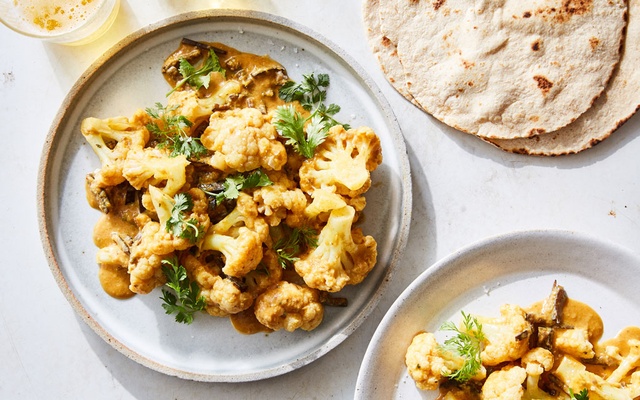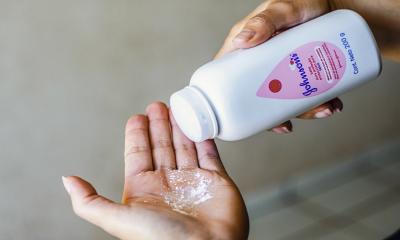In November, British cookbook author and food personality Nigella Lawson shocked her nation when she demonstrated a recipe from her latest cookbook, “Cook, Eat, Repeat,” on her BBC television show of the same name. It wasn’t royal family-level scandalous. Still, based on public reaction, you’d think she’d caused a major controversy.
And all because she’d prepared a fragrant dish of cauliflower — and banana peels.
“I certainly didn’t expect newspaper headlines about it!” she said in an email. “It’s hard to overcome the cultural assumptions about what is and is not edible, and to start eating what we have customarily regarded as waste.”
A few months earlier, another British culinary television star and cookbook author, Nadiya Hussain, had appeared on a “Good Morning Britain” segment on cooking during lockdown. “Everyone’s making banana bread,” she explained, offering resourceful tips on using scraps to avoid food waste. “Don’t chuck the peel away. Cook it up with some garlic and onions and barbecue sauce, stick it in a burger, and you’ve got, like, pulled pork, pulled chicken.”
After Lawson’s show aired, Hussain’s previous appearance resurfaced, and the peels became a culinary cause celebre. “Nigella Lawson shocks viewers with banana skin recipe,” read one Independent headline. “Are banana skins about to become a must-eat ingredient?” wondered the Guardian.
Hussain, whose parents are Bangladeshi, credits her father, a former chef and restaurant owner, for introducing her to cooked peels. In Bengali cuisine, unripe skins are cooked until soft, then puréed with garlic and green chiles, and sauteed with additional seasonings.
As Lathika George, author of “The Kerala Kitchen,” said, “Different varieties of banana grow all over India and there are recipes for all parts of the plant — flowers, fruit and even the trunk of the plant!”
In the southwest region of India’s Kerala state, where George was born, unripe bananas are most commonly associated with a thoran, a type of stir-fry for which they’re soaked then sauteed with a bouquet of bloomed spices and an aromatic, chile-warmed paste of ground coconut. Some adaptations include the peels, while others feature them on their own. “As the skin and flesh of green unripe banana is like a vegetable, it is also used for kofta (mashed-vegetable dumpling), cutlets and vegetable curries,” George added.
Travel north and you’ll find dishes that feature riper skins. George cited an Assamese khar from the northeastern part of India that calls for the ripe, sun-dried peels of an indigenous strain of banana. “Personally, I think it’s just a fad, especially if you’re vegan and looking for different options,” she said of the hype in Britain.
Banana skins have been trendy among vegans since at least 2019, when online recipes began circulating for treating the peels like bacon. At around the same time, the pulled not-pork had its first brush with internet fame, courtesy of Canadian blogger Melissa Copeland, who published an explainer — and recipe — on her site the Stingy Vegan along with a video on Facebook. She’d developed it after learning that vegans in Venezuela use bananas’ outer jackets for an alternative to carne mechada (shredded beef), and in Brazil a similar swap is popular in a dish known as carne louca (or “crazy meat”). Copeland’s “pulled” peels “made it onto the menus of several restaurants in places as far away as Hawaii, Malta and New Zealand thanks to this recipe!” she wrote in an update to her original article a few months after posting it.
For American author Lindsay-Jean Hard, the appeal of cooking with banana peels extends beyond interests in veganism. She has spent the past 11 years learning as much as possible about utilizing the jettisoned parts of her produce. Her 2018 cookbook “Cooking With Scraps” includes a recipe for her grandmother’s banana cake layered with brown sugar frosting, and one notable change: She substituted the fruit with its peels, softening them with a simmer, then pureeing them with some of their cooking liquid. (She has subsequently realized that freezing them in advance takes care of the softening.) She applies the same technique to banana bread, utilizing the whole fruit — casing and flesh — for “even more banana flavor.”

Cauliflower and banana peel curry, in New York, April 28, 2021. Nigella Lawson’s curry treats banana peels as a vegetable without sacrificing flavor or texture. Food styled by Judy Kim. (Linda Xiao/The New York Times)
Now that Hard is a marketer at the Zingerman’s Bakehouse in Ann Arbor, Michigan, she encouraged the bakery to put peels in all of the banana bread it produces and ships across the country. It’s an “impact on a larger scale,” she said. “We compost a lot at the bakehouse, and composting is great, but it’s not as great as eating the food and not wasting it in the first place.”
But eating the peels might not be as great as choosing another fruit altogether or being more selective about which bananas you purchase. Among other reasons, bananas are one of the crops with the worst track records when it comes to environmental harm, according to Lauren Ornelas, founder and president of the Food Empowerment Project in San Jose, California, a nonprofit organization that seeks to educate people about their relationship to their food systems. “There’s a whole lot wrapped up in that piece of fruit, that it involves colonization, sexism, racism, just in that one fruit,” she said.
She recommends buying bananas from a fair trade source, citing Equal Exchange as a reliable resource for produce that’s been grown and traded under ethically and environmentally sound conditions.
Hard has received only praise for her banana cake. And of her curry, Lawson reported that the feedback from those who have actually made it has only been positive. “I don’t think I’ve received one negative comment from anyone who’s cooked it themselves,” she said. “Some, certainly, said that they had doubts before they tasted it, but felt that they just had to try for themselves and were universally delighted.”
British food columnist Felicity Cloake was among them. “I had to try it because there wasn’t much promising going on at the time,” she said. “And it did blow my mind. I did like it.”
In truth, the flavor of the cooked skins isn’t too pronounced — it’s subtle, with a polite suggestion of bitterness, and a slight floral note on the finish. Lawson believes that “if you had to guess what the cut up banana peels were, without knowing, you’d be much more likely to think them related to eggplant.” That’s how she uses them, in ratatouille as well as in this dish. She deploys a traditional method for preparing curry — frying a concentrated savory paste, then adding coconut milk to form a sauce. Once the peels are tossed into the pan, Lawson marvels at how they “take on a luscious velvety texture.”
For those who remain unconvinced, she offered this last encouragement: “If you took a bite out of a raw potato, you’d never guess at the utter deliciousness of a french fry!” A few moments later she followed up with a postscript: “I rather feel I should have added an expectation-managing sentence after comparing the cooked banana peels to fries though!” No, they will never be fries. But they’re not scandalous, and yes, you can eat them.
Whole-Banana Bread
Recipe from Nadiya Hussain
Adapted by Charlotte Druckman
Yield: 1 (8-inch) loaf
Total time: 1 1/2 hours
Ingredients:
1/2 cup/100 grams virgin (unrefined) coconut oil, plus more for greasing the pan (see tip)
2 ripe bananas
2 1/4 cups/280 grams all-purpose flour, plus 1 1/2 teaspoons for tossing peels
1/4 cup/64 grams tahini (or nut butter of your choice)
1/3 cup/80 milliliters oat milk, nut milk or dairy milk of your choice
1 teaspoon almond extract
1 teaspoon vanilla extract
3/4 teaspoon fine sea salt
1 1/3 cups/200 grams coconut palm or dark brown sugar
1/4 cup/20 grams unsweetened cocoa powder
2 teaspoons baking powder
Unsalted vegan or nonvegan butter (optional), for serving
Preparation:
1. Heat the oven to 350 degrees. Grease an 8 1/2-by-4 1/2-by-2 1/2-inch loaf pan with coconut oil and line it with parchment.
2. Wash the bananas then trim and discard the tips. Peel the bananas, then slice the peels crosswise into 1/4-inch-thick strips. Place them in a small bowl and toss with 1 1/2 teaspoons flour to coat; set aside.
3. In a large bowl, use a fork to smush the bananas into a rough purée. (Don’t worry about small lumps.) Add the coconut oil, tahini, oat milk, almond and vanilla extracts, and salt. Beat together with a whisk to thoroughly incorporate and create a thick batter. Add the sugar and beat with the whisk to combine.
4. Sift the flour, cocoa powder and baking powder into the batter and fold it in using a rubber spatula until no streaks remain. Fold the floured banana peels into the batter.
5. Scrape the batter into the prepared loaf pan and smooth the top into an even layer. Bake for about 55 to 65 minutes, until a cake tester or toothpick inserted in the center comes out clean.
6. Let the loaf cool in the pan for 10 to 15 minutes, then lift it out onto a baking rack using the parchment. Let it cool a bit, then serve warm with butter slathered on top, if using, or let it cool completely if you want to store it for later. (Wrapped tightly, the bread will keep at room temperature for about four days.)
Tips:
Unrefined, virgin coconut oil is recommended here because it lends coconut flavor. Refined coconut oil would also work, but since it’s a neutral-flavored oil, your banana bread won’t have as pronounced coconut flavor.
Cauliflower and Banana Peel Curry
Recipe from Nigella Lawson
Adapted by Charlotte Druckman
Yield: 2 to 4 servings
Total time: 1 hour, plus soaking and cooling
Ingredients:
3 large banana peels, tough stems and bottom ends trimmed
1 small cauliflower and tender leaves, trimmed into bite-size florets (about 5 cups)
1 1/4 teaspoons ground turmeric
Fine salt
1/4 pound shallots (about 2 to 3 large shallots), peeled and roughly chopped
1 (1 1/2-inch) piece fresh ginger, peeled and sliced into thick coins
1 fresh red chile (such as bird’s-eye or Fresno), quartered
4 fat garlic cloves
1 small bunch cilantro, stems separated and reserved, leaves chopped
3/4 teaspoon ground cinnamon
1 tablespoon vegetable oil
2 tablespoons tomato paste
1 (13-ounce) can full-fat coconut milk
2 1/2 tablespoons lemon juice
1 1/2 teaspoons sugar
2 teaspoons flaky sea salt, plus more to taste
Cooked rice or flatbread (such as naan or roti), for serving (optional)
Source: The New York Times Company











-20251227141313.jpeg)












-20251226062607.webp)












